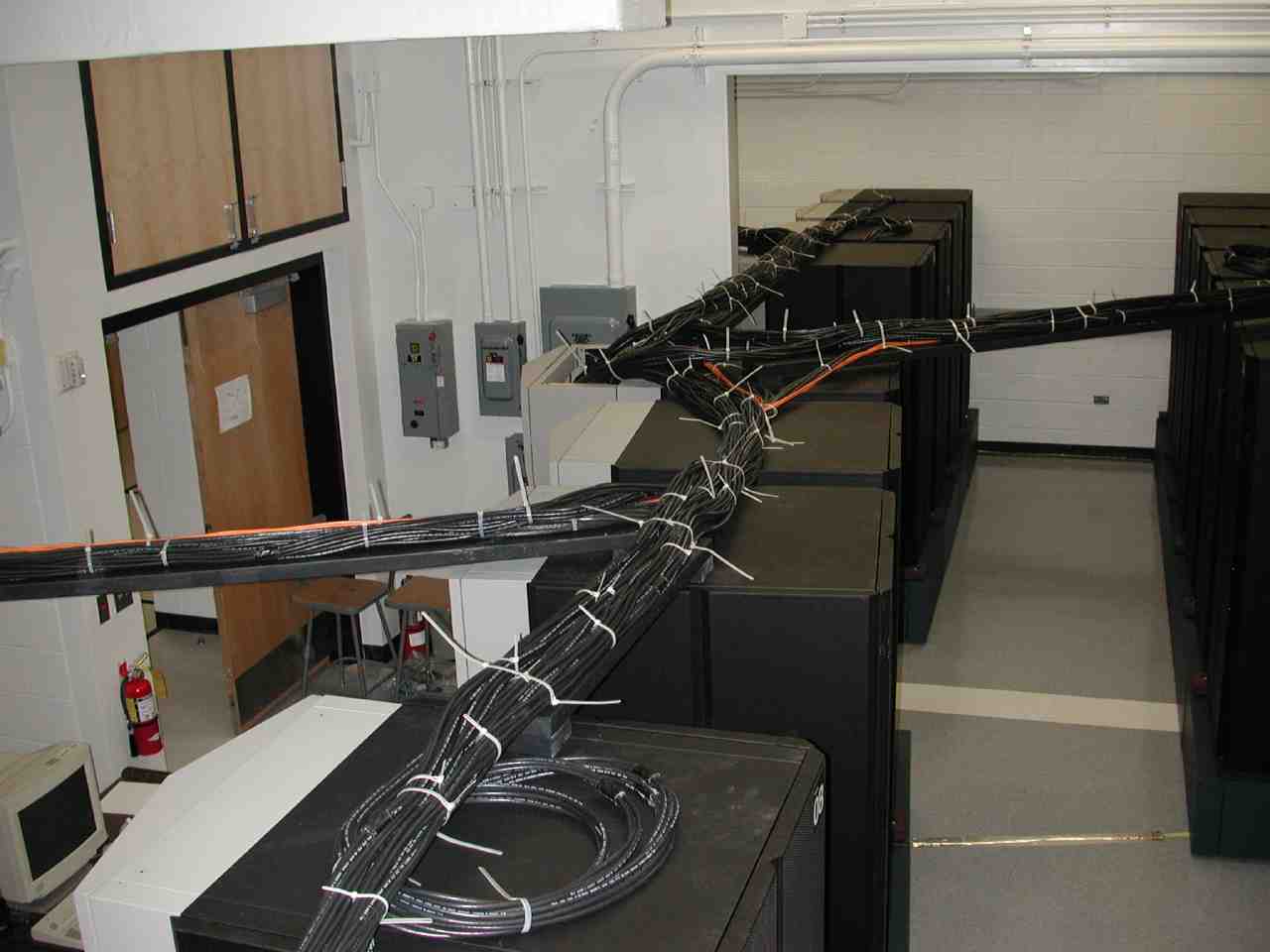Slater Computing Laboratory
|
Introduction to and overview of computing at QTP
Erik Deumens
Director for Computing
QTP Seminar Aug 31, 2005
History
|
Era
|
Servers
|
Desktops
|
Network
|
OS
|
Disk
GB
|
Performance
Mflop/s
|
Space
sq.ft
ton
|
|
1982-1987
|
VAX 11-780
|
vt100
|
9,600
|
VMS
|
.2
|
.1
|
300
9
|
|
1985-1989
|
VAX 11-750
FPS 164
|
-
|
10B2
|
VMS
|
.5
|
10
|
600
9
|
|
1987-2005
|
SUN 3/260
->
SUN v490
|
SUN 3/50
->
SunBlade 1500
|
10B2, 10B2
->
1000BT, 100BT
|
SunOS
->
Solaris
|
10
->
2,000
|
5
->
20,000
|
1500
30
|
|
1991-1996
|
RS/6000 550,590
|
-
|
FDDI
|
AIX
|
10
|
650
|
-
-
|
|
1996-2005
|
RS/6000 SP
272 nodes
|
-
|
100BT
|
AIX
|
3,000
|
70,000
|
2900
60
|
|
2004-2005
|
x86 cluster
180 nodes
|
-
|
1,000BT
|
Linux
|
5,000
|
800,000
|
-
-
|
top
Network
-
UF is part of Internet2, Florida Lambda Rail, National Lambda Rail: 10
Gb/sec
-
UF core is dual GigE fiber.
-
NPB and QTP connect with GigE fiber.
-
QTP has a core of two GigE switches connecting all servers: one for
black-net connecting servers in NPB 2250 to the gateway and one for
service-net, connecting servers in NPB 2250 and NPB 1114.
-
Desktops are connected at 100BT.
Future
-
October 2005: Upgrade of internal QTP network to improve network
access to desktops.
-
Fall 2005: Upgrade of phones in NPB to VoIP with one computer port per
phone. Details to be worked out.
-
Longterm: desktops and laptops will become user responsibility and
networks outside server rooms will become CLAS end eventually UF
responsibility, not departmental or QTP.
top
Security
-
The QTP gateway is an active firewall that only passes traffic in or out that
is explicitly allowed.
-
This protects all QTP systems from most
malicious attack from the outside.
-
It also protects UF from many, but not all, attacks from compromised
hosts inside QTP.
-
The QTP gateway provides NAT (network address translation) for some ranges of
private IP addresses, including all DHCP address.
-
This allows all
unmanaged hosts to access resources outide QTP
- It ensures that no
connection to any private IP host inside QTP can be initiated by an
outside host.
-
All printers and all cluster nodes are completely inaccessible from
the outside.
Still necessary
-
UF campus license for McAffee: make sure your laptops are up-to-date.
-
Maintain OS patches: especially Windows, but also Linux and MacOS.
top
Servers
-
Network of servers provide basic services:
-
general: NTP, DNS
-
e-mail: SMTP (sendmail), IMAPS, POP2S
-
web-server: HTTP (apache)
-
disk space: 26 GB home backed up every weeknight for disaster recovery and
user error; 1 TB scratch space
-
printer and disk access: SMB (samba)
-
Windows servers WIN2K CHEM2K: access to Windows software using RDP protocol.
-
Development servers BUDDY, LINX32, LINX64: for testing and debugging
Future
-
October 2005: Two new servers will replace aging CRUNCH; 1 TB home
space.
top
Desktops and laptops
-
There are two types of desktops:
- Managed These are managed by me, either Solaris stations or
Windows desktops for staff. The Solaris desktops have a static public
IP. The Windows boxes have a static private IP address.
- Unmanaged These are desktops and laptops of QTP
members. The IP address is assigned through DHCP.
-
All private IP addresses assigned to managed or unmanaged hosts fall
in a range that will be translated to a public address at the QTP
gateway to access UF and Internet resources.
Future
-
Only staff desktops will be managed desktops.
-
Everyone will connect their desktop and or laptop through their phone.
top
HPC clusters
-
Xena Era coming to an end:
-
Xena III is left, 1 TB GPFS file system is
still unique and useful
-
Simu cluster still useful because of speed.
-
Linux Era starting:
-
Many nodes with very fast CPUs and large RAM and
GigE connection.
-
5 TB served by 3 NFS servers
-
Suitable for small parallelism: g03 2 CPU, Amber 8 to 12 way, etc.
Future
-
Integrate with UF HPC, become part of the grid
-
UF HPC phase II: over 1,000 AMD 2.2 GHz CPUs in 200 nodes connected by
InfiniBand (10 Gigabit/sec)
top
Data management
-
It is standard practice to manage computation: job categories and
batch systems and now grids.
Why not data?
-
QTP always managed data by user decision
-
valuable data you type in by hand: papers, source code scripts
(/home); backed up every night. Now: 30 GB, backup: 2 hours,
recovery of a file: 2 hours.
-
important and long lived data needed all the time, such as
programs developed and maintained by a group: executables, libraries,
machine generated source code (/camp; backed up at least once a
week. Now 30 GB.
-
really big and temporary data generated by a computation needed
during the computation (/scr_1/tmp/$hostname.xyz.$$; deleted
every morning once process with ID $$ is no longer running on $hostname.
-
really big and long lived data needed for a project
(/scr_1/tmp/keep.xyz.dd-mm-yy); deleted once the date dd-mm-yy
has passed. User must do backup.
-
really big and valuable data generated by months of computation
for a project (special directory like /scr/arwen_1/hui); never
deleted. User must do backup.
-
To back up 1 TB on modern 200 GB LTO2 tapes takes 8 hours with a
modern robot.
top
Website
-
All policies and descriptions are online at
http://www.qtp.ufl.edu/slaterlab
-
All documentation is online at
http://www.qtp.ufl.edu/slaterlab/docs
-
General computing has information for connecting and using your
laptop, downloading UF Letterhead, printing posters, a link to all
online manuals for maintained software, and more.
-
High Performance Computing has information on how to use the
cluster, using LoadLeveler and OpenPBS, parallel programming, disk
space management guide, and links to computational software available
on the systems.
-
Status of all clusters can be seen at
http://www.qtp.ufl.edu/slaterlab
under : click on the name of the cluster.
top
Last modified 28 Aug 2005
|




